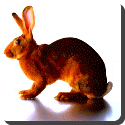 Hare — Hares and jackrabbits are leporids belonging to the genus Lepus. (Four other species of leporid in the genera Caprolagus and Pronolagus are also called “hares”.) Very young hares are called leverets.
Hare — Hares and jackrabbits are leporids belonging to the genus Lepus. (Four other species of leporid in the genera Caprolagus and Pronolagus are also called “hares”.) Very young hares are called leverets.
They are very fast moving. The European Brown Hare (Lepus europaeus) can run at speeds of up to 70 km/h (45 mph).
Hares live solitarily or in pairs, whilst “a drove of hares” is the collective noun for a group of hares.
A common type of hare in arctic North America is the Snowshoe Hare, replaced further south by the Black-tailed Jackrabbit, White-tailed Jackrabbit and other species.
Normally a shy animal, the European Brown Hare changes its behaviour in spring, when hares can be seen in broad daylight chasing one another around meadows; this appears to be competition between males to attain dominance (and hence more access to breeding females). During this spring frenzy, hares can be seen “boxing”; one hare striking another with its paws (This is probably the origin of the term “mad as a March hare”). For a long time it had been thought that this was more inter-male competition, but closer observation has revealed that it is usually a female hitting a male, either to show that she is not yet quite ready to mate, or as a test of his determination.
Hares do not bear their young below ground in a burrow as do other Leporidae, but rather in a shallow depression or flattened nest of grass called a form. Young hares are adapted to the lack of physical protection offered by a burrow by being born fully furred and with eyes open. They are hence able to fend for themselves very quickly after birth, that is to say they are precocial. By contrast, the related rabbits and cottontail rabbits are altricial, having young that are born blind and hairless.
All rabbits (except the cottontail rabbits) live underground in burrows or warrens, while hares (and cottontail rabbits) live in simple nests above the ground, and usually do not live in groups. Hares are generally larger than rabbits, with longer ears, and have black markings on their fur. Hares have not been domesticated, while rabbits are often kept as house pets.
The hare’s diet is very similar to that of the rabbit.
 Kids Portal For Parents India Kids Network
Kids Portal For Parents India Kids Network






